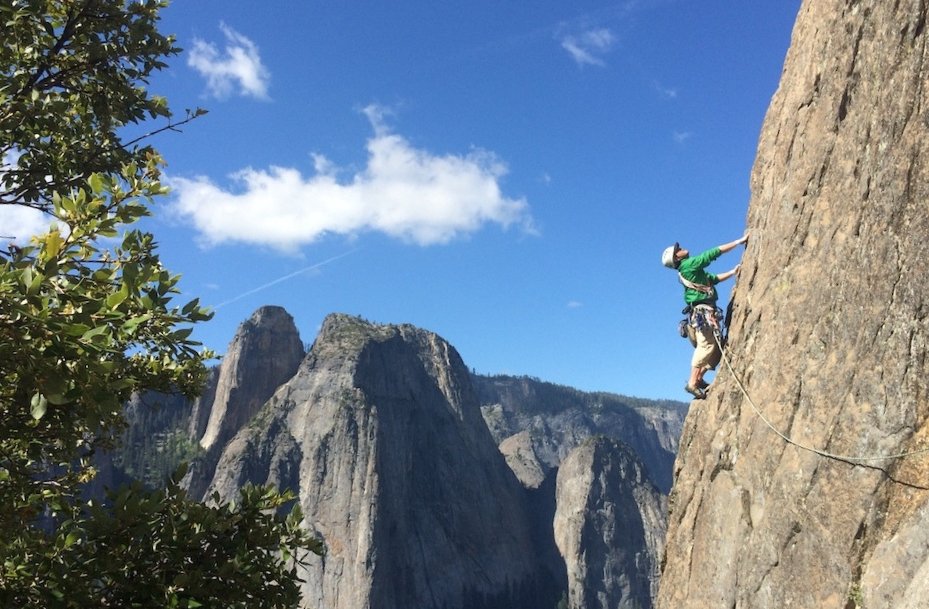It’s so fulfilling when a plan comes together. Picking a route, finding the right time, dialing in the right gear, and then getting ready for the send—it’s such a sweet moment when you execute the plan to perfection and take in the views from the top.
Access Fund Executive Director Chris Winter on the East Buttress of El Capitan. Ancestral lands of the Bishop Paiute, Bridgeport Indian Colony, Mono Lake Kootzaduka’a, North Fork Rancheria of Mono Indians of California, Picayune Rancheria of Chukchansi Indians, Southern Sierra Miwuk Nation, and Tuolumne Band of Me-Wuk. © John Connor
But fitting climbing into our lives can be frustrating as well. Weather, old injuries, or even work can get in the way. So we constantly refresh the weather report, obsess over training plans, and stay on top of work so when the clock strikes five we can hit the door running. Sometimes, despite our best efforts, things that are bigger than climbing manage to get in the way.
Right now, the climbing advocacy movement is stronger than ever—but it’s facing a similar situation. For more than 30 years, Access Fund has led the climbing community in buying threatened crags, restoring climbing areas across the country, and advocating for sustainable climbing access in Washington, D.C. Because of that hard work, crusty trad dads, improbably strong kid crushers, and everyone in between can enjoy the connection to the land that ties us all together as a community.
But all that progress is at risk as climbers square up to some of the biggest issues we’ve ever had to overcome. Climate change is increasing the frequency and intensity of wildfires in the places we climb. Just last year, the Caldor Fire ripped through Lover’s Leap, California and the surrounding area, delaying the much-needed restoration work we had planned there.
Earlier this year, a massive energy project threatened climbing and residential areas in Unaweep Canyon, Colorado, including land Access Fund purchased decades ago with money contributed by the climbing community to ensure permanent access and conservation. The energy project leader recently withdrew their plans—for now—but their future moves are unknown.
And every day we’re seeing greater impact on soils, vegetation, and wildlife habitat as more and more people get out on the land. Climbers know the benefits of time spent outside—so how do we ensure that access for everyone is equitable and sustainable while still protecting the incredible places that inspire us for the long term?
These are monumental challenges, perhaps the most important ones of our time, and they are pushing the boundaries of our work as climbing advocates. As climbers, we are starting to realize how many of these issues that once seemed far removed from racking up and sending a beautiful line may actually intersect with climbing and shut us down.
If we truly care about climbing, we can’t be afraid to take the lead on these larger issues of conservation, protection of public land, and equitable access to the outdoors.
If we truly care about climbing, we can’t be afraid to take the lead on these larger issues of conservation, protection of public land, and equitable access to the outdoors. We have to work with those who share our values. We have to invite every last person in this country into the conservation movement to protect the outdoors so generations to come can have sustainable access to the wild landscapes that climbers cherish.
We’ve proven we can do it. In the last several years, climbers have played a leading role in protecting more than 4 million acres of public lands across the country. We have helped to secure over $15 billion to support the care and management of public lands. And Access Fund has been invited to the White House three times in the last year alone to represent climbers on important policy initiatives.
So keep plugging cams and clipping bolts. Keep building trails and using wag bags. But you can also send advocacy letters, talk to your elected representatives, and chip in on these larger issues of conservation, access, and equity. The future of climbing depends on it.
Chris Winter, Executive Director, Access Fund
Chris provides strategic leadership and manages organizational health, working with the board of directors, staff, and partners to fulfill on Access Fund's mission to keep climbing areas open and conserve the climbing environment.


